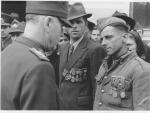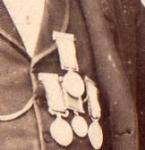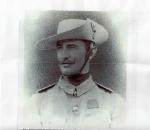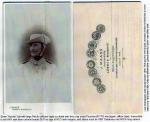-
Posts
7,155 -
Joined
-
Last visited
-
Days Won
5
Content Type
Profiles
Forums
Blogs
Gallery
Events
Store
Everything posted by Ulsterman
-
Well, quodos to Les for making me look again. I thought the Leib regiment wore red jackets at Lagansalza. Now I shall go back and look at Michaels' pictures again. Michael did put up the Knoetel plates but I think there are also Funken (Lillian and Fred) water-colours as well. Shame- it's understandable that Hanover went to the "Union"/Prussian blue, but IMHO they looked better with scarlet coats. I have seen pictures of the Kings in exile wearing scarlet, but too little, too late.
-
As we all know, after the Pyrrhic victory at Lagansalza in 1866, the plucky Hanoverian army was forced back and pinned against the mountains by rapidly advancing Prussian troops. Unable to unite with their South German and Austrian allies, the plucky red (ooops- blue)-coated soldiers fought on against impossible odds until their King was safely away into exile in Vienna-never to return. Shortly thereafter the Prussians destroyed the Austrians and their allies at Koeniggratz and the Hohenzollern annexation of Hanover was a' fait-acomlpis. The Hanoverian King meanwhile had instituted the Lagansalza victory medal- similar to the famous and well respected Waterloo medal that was awarded to many of the Hanoverian soldiers ' fathers and grandfathers. Indeed several Waterloo alumni were at Lagansalza. In an unusual display of lese majestie', the Prussian King allowed the wear of the Lagansalza medal as of the Spring of 1867. This was shortly after the Hanoverian medals began to be handed out by the exiled royal house in Vienna. Thus, by 1870, a number of "Prussian" officers were wearing medals signifying a Prussian defeat as they got shot to pieces at places like Mars le Tour and Sedan. Thanks to the good graces of Herr Michael Taenzer of the H.G.S., I have an on-line file of the Hanoverian Officer Corps as of the battle in 1866, with subsequent notes up to 1895. Herr Rick Research is already hard at work ferreting out unknown facts and indexing the officer's names. I am willing to send via email, the pdf. file of this "alumni List" (@ 750 names) and the OOB for 1866 to any dues paying member, Old Sweat, Host, Moderator etc. who asks. Just drop me a pm. "Membership has its privileges." as Amex says.....
-

EK 1914 Who got what and when....
Ulsterman replied to Chris Boonzaier's topic in Germany: All Eras: The Iron Cross
Hmmm...that's an interesting question. I have the complete awards roster for a Bavarian artillery regiment. There were a lot more BMVKxs awarded than EKs. ........And almost every officer got a BMVOx..... and every "combat" officer got an EK2 at least. I would like to know who determined what, but I reckon it was Company Commander- regimental commander, final signature by the Brigadier. but the real decider was the Battalion CO. -
Yes and no- the iron cross was also awarded for merit and its award as a "upper class signifier" to staff/support men was deeply resented by front soldiers. This is one of the reasons Hitler wore his EK1 and his wound badge. As an award to a Gefreiter, his EK1 was as statistically rare as a PLM to an officer. It said "been there, done that". Secondly, as the war went on the EK was awarded more and more frequently. In 1914-15 the EK had enormous prestige and officers hungered for it. By the end of the war, if an officer did not have an EK, he was viewed as a boob. Of the 12 million Germans who served in uniform in one capacity of another, the EK2 was awarded to @ 40% at least. If one subtracts rear echelon Landwehr, clerks, nurses, signalers, drivers etc. who had no chance to receive what was ostensibly a combat decoration -and the dead who were KIA before they got a chance to earn an EK2- then the statistic is probably closer to 65%. That's a LOT of iron crosses.
-

Long Service Good Conduct Medals
Ulsterman replied to muckaroon1960's topic in United States of America
The GC is a really interesting medal. It was one of the two that most guys got in 1945/46 when they were discharged. there is a great OMSA article about the army versions. Do you have any numbered early ones? -
Meet Zahlmeister Buehring (I don't have an umlaut on my keyboard program), Mecklenburg Jaeger Battaion 14 @ 1879-1887. Georg Buehring born Feb. 27, 1825 in Roggendorf, Mecklenburg- Schwerin. After a long NCO service in the artillery (Oberfeurwerker in 1860) he was commissioned as a Zahlmeister on December 1, 1863 into FAR 9. He was not listed in the 1872 Meck.-Schwerin Staats-Kalender since his Zahlmeister posting was in the Prussian army until 1879. He was an NCO until 1879. There were only SIX Schwerin Zahlmeister posts at that time. To 1887/88 Rank list Zahlmeister in Mecklenburg Jaeger Battalion 14 a D. as Char. Rechnungsrat. He was NOT in the 1908/09 Ordnungs-Almanach, but alive in 1905 as per the Prussian Ordensliste- His medal bar shows- 1. Mecklenburg-Schwerin Wend. Crown Silver Merit Cross (awarded between 1879-1883) 2. CO 4 : 18.01.1879 3. Prussian AEZ in Silber (Oberfeurwerker) : 19.09.1860 4. Mecklenburg 1848/49 campaign medal (1879)-how rare is that! 5. BADEN 1849 campaign medal (served in Denmark above and Baden here).....Baden's "thanks for the help M-S troops!" 6. Prussian 1866 Cross-noncombatnt. 7. Prussian 1870/71 in steel on noncombatnt ribbon (served in France) 8. Meck-Schwerin Military XXV service cross Schwerin Staatklaender Lists campaign medals, but Rick has none between 1872-and 1906 Zahlmeister FAR 9 from 17.12.68 in JB 14 from 18.06.72. Rechnungsrat in Schwerin in 1891, from the "History of the FAR 9 (1891). Note the stupidly odd "Italian" style loop suspension requiring "straight" ribbon drapes, disturbing the "hang" of the medals. Buehring took part in 4 wars and never received ANY MMV2! Special Thanks to Glenn!!!! Crappy scan is my fault- sorry chaps.
-
As I mentioned earlier, good cousin Rick had a good day in Boxboro. This is one of the CDVs he grabbed for less than a double mocha latte' vente at Starbucks. Again, through the magic powers of research and a rather odd combination of state awards- it took him a whole hour to identify this guy- unnamed, photographed sometime between Isandulwana and the Spanish-American war. Originally an NCO, through hard work and diligence he was one of the few who managed to break the solid class walls of the German officer corps and rise to higher officer status. He was dead before Germany entered the nightmare of 1914. He lived his life is great times, as the Empire consolidated and Germany went from being a series of poor, disconnected farmlands to a mighty industrial world power. He must have been proud.
-
Well, the casualties are sort of close if one combines "missing" with KIA. David Stone and Warwo have numbers that are similar but I suspect its comparing apples to oranges as in one Bavarians and others are counted and in the other, only field units are counted. Looking more closely in the library this just goes to show you to recheck original sources. Stones' book is a fun read, but he used the 1973 Osprey book for a LOT of his OOB and casualty information. Warwo clearly looked wider and came to no conclusions. Hmmmmmmm...........
-
HA HA! Depends upon the guns. The 12 and 24 lbs and the "new" C/61 (80mm Krupp) were what the Prussians used the most in 1870. They were outgunned by the famous 12lb "Napoleons" (designed by Napoleon IIIrd) widely used in the American Civil War ( and often seen today as memorials in city parks) by -a lot. The French 12lbs and the heavier 24 lbers could fire 5,600 yards. The French used bronze 4lb field guns (pulled by 4 horses) that fired 3,300 yards. Do you mean field guns? The 7.7 cm FK 96 series? 1914=15,000- 23,400 feet ranges..... varied by length of tube: size matters-as you know. I suspect these numbers are wrong, as the German WW1 artillery book I have was -awkwardly translated. Tony Sommerfield will know-there's a whole scholarly journal devoted to ordinance these days. Do you know of the Gesellschaft fuer Artilleriekunde?
-

What Do You See?
Ulsterman replied to Ulsterman's topic in Great Britain: Orders, Gallantry, Campaign Medals
Ah-ha! Brilliant. ......Joan of Arce medal. Thanks Tony!!! I owe you a beer (not one of the new 2% ones either) -

What Do You See?
Ulsterman replied to Ulsterman's topic in Great Britain: Orders, Gallantry, Campaign Medals
Here is a close up. I swear that's an MGS at the top with a couple of bars...and a Waterloo lower right side-although the ring's a bit small..... but maybe it's just wishful thinking.... -
Well, I got this off eBay. I thought it was one of Wellingtons' old hands, but now I look at it it might be a Crimea vet with a LS and regimental medal.
-
...and here he is...identified from an 1897 Centennial medal, a cockade and a printer's stamp: Hans Christian Karl Freiherr von Schleinitz. Born Berlin March 16, 1873 , KIA at Villers-sur-Roye on the 14th of November, 1914, son of char. Vizeadmiral aD Georg Freiherr von Scleinitz (1834-1910) and Margot von Hippel (died, 1887)
-
Last Sunday good cousin Rick (the good one- not the evil one) went to the show in Boxboro, Massacusetts. "Good" Rick had earlier bemoaned the quality of the show, stating that it had become a playground for 395 pound Falschirmjager reenactors, second hand Sven Hassel volumes, patch guys, a Beanie Bay table (the end of the line as far as I am concerned) and other unsavory types. Still, hope springs eternal and I hadn't actually seen Rick since 2010, so I drove down , coffee in hand. Rick had promised to give me a CD of the reedited Lubeck rolls and maybe Ted would be there with a researched artillery sword.......... Paying my $3 to the surly, hefty, cigarette-smoking lady at the coffee table promptly at 8:30 am I was sad to note that many tables had that "attacked by seagulls" look that meant the dealers had already pawed over much of what the local pickers had bought. Walking past the over priced Japanese table on the right end of the 1st row, (where I still hold a grudge, since the WAF moderator who owns it sold me a Japanese fake ribbon bar @ 8 years ago that apparently even a child would have recognized- except me, because I am an idiot)...I stopped at 3 large frame-boxes of imperial CDVs which, given their presentation, I assumed must be vastly expensive. Noone was at the table, the seller being otherwise engaged elsewhere. Whilst gazing at the rows and rows of medal-barred officers and men from @1860-1920 I was called over by another " dealer friend" (e.g. someone who is friendly only when they want information from me- but don't ask for a discount) who wanted to show me a Communist Hungarian trumpet banner. Then Rick arrived...and while i was distracted by questions like "How do you know it is Hungarian? Are you sure it isn't a Hungarian fascist banner? (No- the Horthy regime didn't have big red stars on their flags with "Kivalo Brigagda" on them.....) Rick had the best show of the past 5 years! The CDVs and postcards turned out to be part of a collection that had been bought in toto and were for sale at $5 each. Rick promptly dropped every penny he had and called in a few favors . With glee he showed me the @ 15 or so CDVs he got and my jaw dropped. Sprinting back to the table all that was left for me when i got there was a few 1870 vets, but I managed to beg another collector to sell me one CDV- at $30 more than he paid for it, a picture of a Lt. Oberst @ 1895 that I knew was incredibly rare. I will post that tomorrow. In the meantime, Rick had pulled out a pristine Reichsmarine bullion cap badge that was identified as "Japanese merchant navy" for $2 from an old Nike shoebox and then proceeded to discover another mislabeled piece that he paid $1 for........well...more on that later. Here is one of the CDVs he grabbed- no name -nothing. He identified it in @ 3 hours.
-
There are a number of US federal warehouses all around Virginia, Ohio and even Missouri that have God knows what in them. they were part of the USAF archives and under seal until they could be indexed and since 1945- it's never been part of the USAF budget. So there they sit. Recently in my own state we 'discovered" several shelves of bound pension records from the war of 1812-that had been completely unknown since @ 1880 because they were placed in old financial (receipts) boxes.
-

My First US Coast Guard Pre-WW2 Ribbon Bar
Ulsterman replied to Paul R's topic in United States of America
very cool! I have never seen a pre WW2 bar. -

Need help with Police Officer Breaststar
Ulsterman replied to JT1959's topic in Police Forces of the World
I think it's a US Police Department generic badge. The constables' # was 22. It could be anybodys' badge- from PC Smith of Alligator, Texas to Trooper Rechaumbaud of the Portland, Maine PD. Definitively US though- and similar badges are still issued by some towns and cities. Most today however, prefer the "fancy bling". these are also heavily faked I might add. Have a look on eBay Europe. They are illegal (purportedly) to sell here in the USA.










